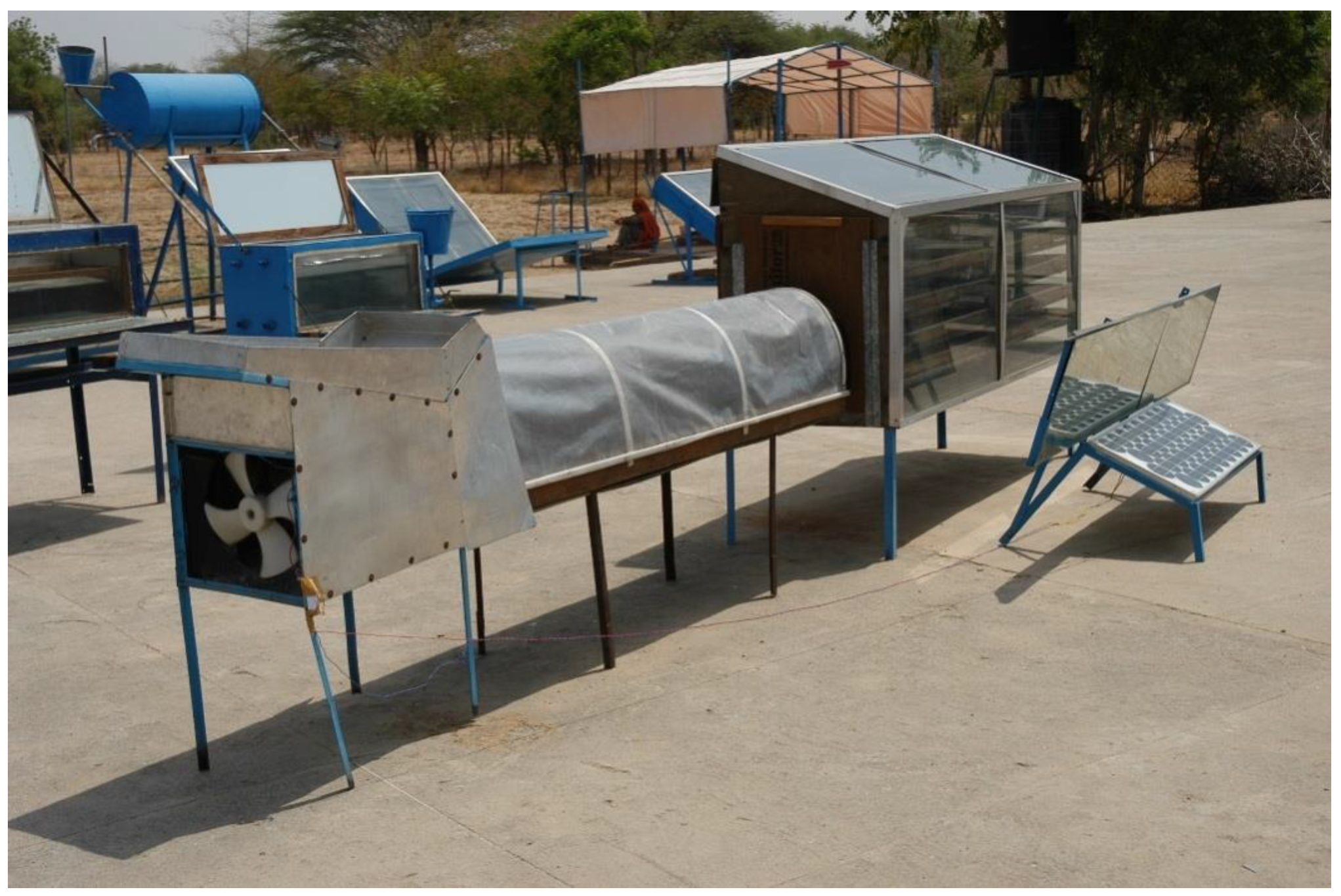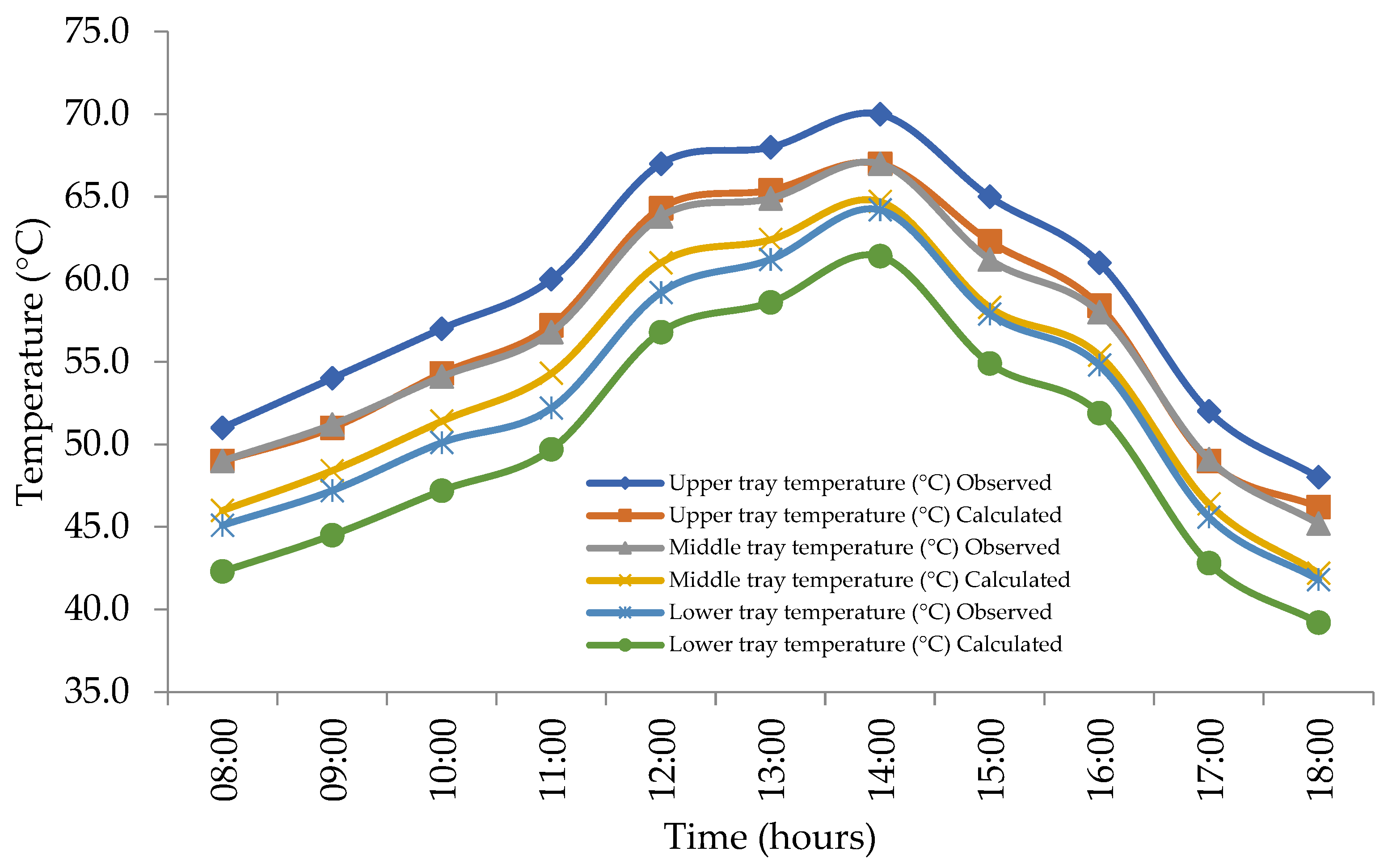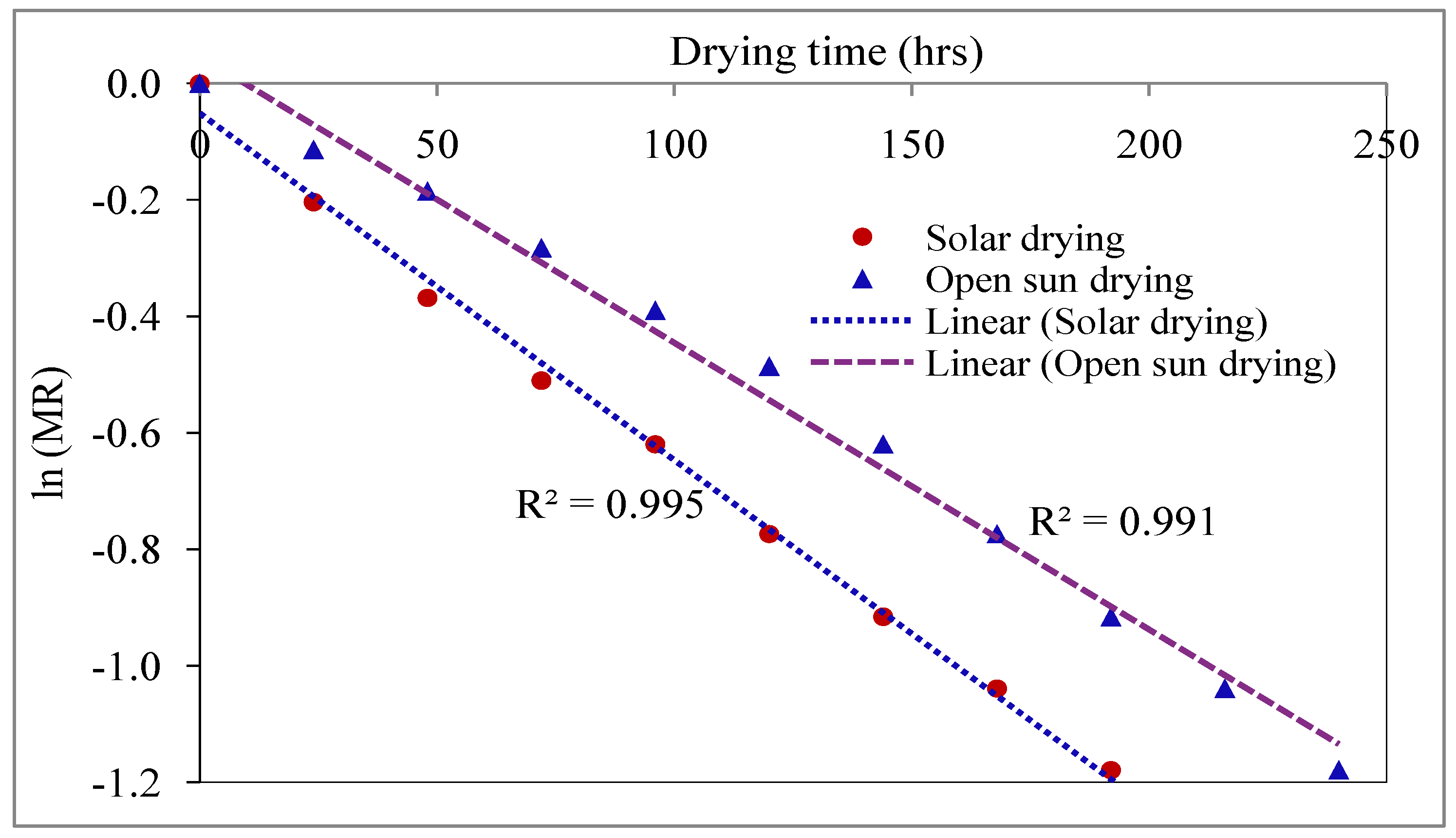Techno-Economic Analysis of Integrated Solar Photovoltaic Winnower-Cum Dryer for Drying Date Palm Fruit
Abstract
1. Introduction
2. Materials and Methods
2.1. Description of the Photovoltaic Winnower Cum Dryer
2.2. Experimental Procedure
2.3. Moisture Content and Moisture Ratio
2.4. Effective Moisture Diffusivity
2.5. Thermal Efficiency (η)
2.6. Economic Analysis of the PV Hybrid Solar Dryer
2.6.1. Net Present Value (NPV)
2.6.2. The Benefit–Cost Ratio (BCR)
2.6.3. Annuity (A)
2.6.4. Payback Period (PBP)
2.6.5. Internal Rate of Return (IRR)
3. Results and Discussion
3.1. Performance Evaluation of the PV Hybrid Solar Dryer
3.2. Effective Moisture Diffusivity (Deff)
3.3. Dryer Overall Efficiency
3.4. Performance Evaluation of the Winnower
3.5. Analysis of Economic Viability
4. Conclusions
Author Contributions
Funding
Institutional Review Board Statement
Informed Consent Statement
Data Availability Statement
Conflicts of Interest
Nomenclature
| Mi | Initial moisture content of the sample (w.b.) % |
| Wi | Initial weight of the sample (g) |
| Wf | Final weight of the sample (g) |
| ΔM | Loss of mass of fruit (kg water·kg−1 dry matter) |
| Δt | Interval of time (min) |
| DR | Drying rate |
| M | Moisture content of the sample at a given time |
| M0 | Initial moisture content of the sample |
| Me | Equilibrium moisture content of the sample (kg water. kg−1 solids) |
| Deff | Effective diffusivity coefficient (m2·s−1) |
| r | Half thickness of the sample (m) |
| n | Positive integer |
| t | Drying time (s) |
| η | Efficiency of the solar dryer (%) |
| A | Absorber area (m2) |
| HT | Solar radiation on the horizontal plane (J.m−2·h−1) |
| L | Latent heat of vaporization (J·kg−1) |
| M | Mass of moisture evaporated from the product (kg) |
| θ | Period of test (h) |
| a | Compound interest rate per annum |
| IC | Initial cost of the dryer (INR) |
| E | Gross benefits from the sale of products (INR) |
| M | Maintenance cost of the dryer (INR) |
| n | Number of years |
| NPV | Net present value (INR) |
| BCR | Benefit–cost ratio |
| A | Annuity (INR) |
| PBP | Payback period (years) |
| IRR | Internal rate of return (%) |
References
- Ahmed, I.A.; Ahmed, A.W.K.; Robinson, R.K. Chemical composition of date varieties as influenced by the stage of ripening. Food Chem. 1995, 54, 305–309. [Google Scholar] [CrossRef]
- Al-Turki, S.; Shahba, M.A.; Stushnoff, C. Diversity of antioxidant properties and phenolic content of date palm (Phoenix dactylifera L.) fruits as affected by cultivar and location. J. Food Agric. Environ. 2010, 8, 253–260. [Google Scholar]
- Uchoi, J.; Nikhumbhe, P.H.; Kumar, A.; Patidar, A.; Harish, G.D. Impact of inclined solar drier for dehydration quality in khadrawy dates during doka maturity stage at north western arid India. Int. J. Curr. Microbiol. Appl. Sci. 2020, 9, 119–125. [Google Scholar] [CrossRef]
- Kulkarni, S.G.; Vijayanand, P.; Aksha, M.; Reena, P.; Ramana, K.V.R. Effect of dehydration on the quality and storage stability of immature dates (Pheonixdactylifera). LWT-Food Sci. Technol. 2008, 41, 278–283. [Google Scholar] [CrossRef]
- Sagarika, N.; Kapdi, S.S.; Sutar, R.F.; Patil, G.B.; Akbari, S.H. Study on drying kinetics of date palm fruits in greenhouse dryer. J. Pharmacogn. Phytochem. 2019, 8, 2074–2079. [Google Scholar]
- Poonia, S.; Singh, A.K.; Jain, D. Mathematical modelling and economic evaluation of hybrid photovoltaic-thermal forced convection solar drying of Indian jujube (Zizyphusmauritiana). J. Agric. Eng. 2018, 55, 74–88. [Google Scholar]
- Poonia, S.; Singh, A.K.; Jain, D. Design development and performance evaluation of photovoltaic/thermal (PV/T) hybrid solar dryer for drying of ber (Zizyphusmauritiana) fruit. Cogent Eng. 2018, 5, 1–18. [Google Scholar] [CrossRef]
- Poonia, S.; Singh, A.K.; Jain, D. Design development and performance evaluation of concentrating solar thermal desalination device for hot arid region of India. Desalination Water Treat. 2020, 205, 1–11. [Google Scholar] [CrossRef]
- Purohit, P.; Kumar, A.; Kandpal, T.C. Solar drying vs. Open Sun drying: A framework for financial evaluation. Sol. Energy 2006, 80, 1568–1579. [Google Scholar] [CrossRef]
- Poonia, S.; Singh, A.K.; Santra, P.; Jain, D. Performance evaluation and cost economics of a low-cost solar dryer for ber (Zizyphusmauritiana) fruit. Agric. Eng. Today 2017, 41, 25–30. [Google Scholar]
- Sharma, A.; Chen, C.R.; Vu Lan, N. Solar-energy drying systems: A review. Renew. Sustain. Energy Rev. 2009, 13, 1185–1210. [Google Scholar] [CrossRef]
- Mahapatra, A.K.; Imre, L. Role of solar agricultural drying in developing countries. Int. J. Ambient. Energy 1990, 2, 205–210. [Google Scholar] [CrossRef]
- Sodha, M.S.; Chandra, R. Solar drying systems and their testing procedures: A Review. Energy Convers. Manag. 1994, 35, 219–267. [Google Scholar] [CrossRef]
- Ekechukwu, O.V.; Norton, B. Review of solar energy drying systems II: An overview of solar drying technology. Energy Convers. Manag. 1999, 40, 615–655. [Google Scholar] [CrossRef]
- Hossain, M.A.; Woods, J.L.; Bala, B.K. Optimisation of solar tunnel drier for drying of chilli without color loss. Renew. Energy 2005, 30, 729–742. [Google Scholar] [CrossRef]
- Zondag, H.A. Flat-plate PV-Thermal collectors and systems: A review. Renew. Sustain. Energy Rev. 2008, 12, 891–959. [Google Scholar] [CrossRef]
- Huang, B.J.; Lin, T.H.; Hung, W.C.; Sun, F.S. Performance evaluation of solar photovoltaic/thermal systems. Sol. Energy 2001, 70, 443–448. [Google Scholar] [CrossRef]
- Tonui, J.K.; Tripanagnostopoulos, Y. Air-cooled PV/T solar collectors with low-cost performance improvements. Sol. Energy 2007, 81, 498–511. [Google Scholar] [CrossRef]
- Sharma, M.; Atheaya, D.; Kumar, A. Exergy, drying kinetics, and performance assessment of Solanumly copersicum (tomatoes) drying in an indirect type domestic hybrid solar dryer (ITDHSD) system. J. Food Process. Preserv. 2022, e16988. [Google Scholar] [CrossRef]
- Barnwal, P.; Tiwari, G.N. Grape drying by using hybrid photovoltaic–thermal (PV/T) greenhouse dryer: An experimental study. Sol. Energy 2008, 82, 1131–1144. [Google Scholar] [CrossRef]
- Philip, N.; Duraipandi, S.; Sreekumar, A. Techno-economic analysis of greenhouse solar dryer for drying agricultural produce. Renew. Energy 2022, 199, 613–627. [Google Scholar] [CrossRef]
- Çerçi, K.N.; Hürdoğan, E. Performance assessment of a heat pump assisted rotary desiccant dryer for low temperature peanut drying. Biosyst. Eng. 2022, 223, 1–17. [Google Scholar] [CrossRef]
- Tuncer, A.D.; Khanlari, A.; Afshari, F.; Sözen, A.; Çiftçi, E.; Kusun, B.; Şahinkesen, I. Experimental and numerical analysis of a grooved hybrid photovoltaic-thermal solar drying system. Appl. Therm. Eng. 2023, 218, 119288. [Google Scholar] [CrossRef]
- Parhizi, Z.; Karami, H.; Golpour, I.; Kaveh, M.; Szymanek, M.; Blanco-Marigorta, A.M.; Marcos, J.D.; Khalife, E.; Skowron, S.; Adnan Othman, N.; et al. Modeling and optimization of energy and exergy parameters of a hybrid-solar dryer for basil leaf drying using RSM. Sustainability 2022, 14, 8839. [Google Scholar] [CrossRef]
- Pande, P.C. Design and development of PV winnower-cum-dryer. In Proceedings of the International Congress on Renewable Energy (ICORE 2006), Hyderabad, India, 8–11 February 2006; Sastry, E.V.R., Reddy, D.N., Eds.; Allied Publishers Pvt. Ltd.: Mumbai, India, 2006; pp. 265–269. [Google Scholar]
- Pande, P.C.; Singh, A.K.; Dave, B.K.; Purohit, M.M. A preheated Solar PV dryer for economic growth of farmers and entrepreneurs. In Proceedings of the International Congress on Renewable Energy (ICORE 2010), Chandigarh, India, 3 December 2010; Solar Energy Society of India: New Delhi, India, 2010; pp. 68–73. [Google Scholar]
- Pande, P.C. A Solar PV winnower. In Proceedings of the 2003, 26th National Renewable Energy Convention and International Conference in New Millennium, Coimbatore, India, 17–19 January 2003; pp. 22–26. [Google Scholar]
- Ikram, M.; Zhang, Q.; Sroufe, R.; Shah SZ, A. Towards a sustainable environment: The nexus between ISO 14001, renewable energy consumption, access to electricity, agriculture and CO2 emissions in SAARC countries. Sustain. Prod. Consum. 2020, 22, 218–230. [Google Scholar] [CrossRef]
- Chand, A.A.; Prasad, K.A.; Mar, E.; Dakai, S.; Mamun, K.A.; Islam, F.R.; Kumar, N.M. Design and Analysis of Photovoltaic Powered Battery-Operated Computer Vision-Based Multi-Purpose Smart Farming Robot. Agronomy 2021, 11, 530. [Google Scholar] [CrossRef]
- Solangi, Y.A.; Tan, Q.; Mirjat, N.H.; Valasai, G.D.; Khan MW, A.; Ikram, M. An integrated Delphi-AHP and fuzzy TOPSIS approach toward ranking and selection of renewable energy resources in Pakistan. Processes 2019, 7, 118. [Google Scholar] [CrossRef]
- D’Adamo, I.; Gastaldi, M.; Morone, P.; Rosa, P.; Sassanelli, C.; Settembre-Blundo, D.; Shen, Y. Bioeconomy of sustainability: Drivers, opportunities and policy implications. Sustainability 2021, 14, 200. [Google Scholar] [CrossRef]
- Leon, A.M.; Kumar, S.; Bhattacharya, S.C. A comprehensive procedure for performance evaluation of solar food dryers. Renew. Sustain. Energy Rev. 2002, 6, 367–393. [Google Scholar] [CrossRef]
- Singh, A.K.; Poonia, S.; Jain, D.; Mishra, D.; Singh, R.K. Economic evaluation of a business model of selected solar thermal devices in Thar Desert of Rajasthan, India. Agric. Eng. Int. CIGR J. 2020, 22, 129–137. [Google Scholar]
- Mennouche, D.; Boubekri, A.; Chouicha, S.; Bouchekima, B.; Bouguettaia, H. Solar drying process to obtain high standard “deglet-nour” date fruit. J. Food Process Eng. 2017, 40, e12546. [Google Scholar] [CrossRef]
- Boubekri, A.; Benmoussa, H.; Mennouche, D. Solar drying kinetics of date palm fruits assuming a step-wise air temperature change. J. Eng. Sci. Technol. 2009, 4, 292–304. [Google Scholar]
- Boubekri, A.; Benmoussa, H.; Courtois, F.; Bonazzi, C. Softening of over dried ‘DegletNour’ dates to obtain high-standard fruits: Impact of rehydration and drying processes on quality criteria. Dry. Technol. 2010, 28, 222–231. [Google Scholar] [CrossRef]
- Domyaz, I. Drying kinetics of black grapes treated with different solutions. J. Food Eng. 2006, 76, 212–217. [Google Scholar] [CrossRef]
- Doymaz, İ. The kinetics of forced convective air drying of pumpkin slices. J. Food Eng. 2007, 79, 243–248. [Google Scholar] [CrossRef]
- Babalis, S.J.; Belessiotis, V.G. Influence of drying conditions on the drying constants and moisture diffusivity during the thin-layer drying of figs. J. Food Eng. 2004, 65, 449–458. [Google Scholar] [CrossRef]
- Falade, K.O.; Abbo, E.S. Air-drying and rehydration characteristics of date palm (Phoenix dactylifera L.) fruits. J. Food Eng. 2007, 79, 724–730. [Google Scholar] [CrossRef]
- Hashim, N.; Daniel, O.; Rahamann, E. A preliminary study: Kinetic model of drying process of pumpkins (Cucurbita Moschata) in a convective hot air dryer. Agric. Agric. Sci. Procedia 2014, 2, 345–352. [Google Scholar] [CrossRef]
- Kadam, D.M.; Samuel DV, K. Convective flat-plate solar heat collector for cauliflower drying. Biosyst. Eng. 2006, 93, 189–198. [Google Scholar] [CrossRef]
- Dhanushkodi, S.; Vincent, H.W.; Kumarasamy, S. Life cycle cost of solar biomass hybrid dryer systems for cashew drying of nuts in India. Environ. Clim. Technol. 2015, 15, 22–33. [Google Scholar] [CrossRef]
- Swain, S.; Din, M.; Chandrika, R.; Sahoo, G.P.; Roy, S.D. Performance evaluation of biomass fired dryer for copra drying: A comparison with traditional drying in subtropical climate. J. Food Process. Technol. 2014, 5, 294. [Google Scholar] [CrossRef]








| Interest Rate i (%) | |||
|---|---|---|---|
| 12 | 40 | 60 | |
| Net present value (INR) | 113,023 | 13,485 | −2032 |
| Parameters | Values |
|---|---|
| Benefit–cost ratio | 4.41 |
| Net present value | 113,023 |
| Annuity | 14,415 |
| Internal rate of return (percent) | 57.38 |
| Payback perid (years) | 2.10 |
Publisher’s Note: MDPI stays neutral with regard to jurisdictional claims in published maps and institutional affiliations. |
© 2022 by the authors. Licensee MDPI, Basel, Switzerland. This article is an open access article distributed under the terms and conditions of the Creative Commons Attribution (CC BY) license (https://creativecommons.org/licenses/by/4.0/).
Share and Cite
Poonia, S.; Singh, A.K.; Jain, D.; Kumar, N.M.; Singh, D. Techno-Economic Analysis of Integrated Solar Photovoltaic Winnower-Cum Dryer for Drying Date Palm Fruit. Sustainability 2022, 14, 13686. https://doi.org/10.3390/su142013686
Poonia S, Singh AK, Jain D, Kumar NM, Singh D. Techno-Economic Analysis of Integrated Solar Photovoltaic Winnower-Cum Dryer for Drying Date Palm Fruit. Sustainability. 2022; 14(20):13686. https://doi.org/10.3390/su142013686
Chicago/Turabian StylePoonia, Surendra, Anil Kumar Singh, Dilip Jain, Nallapaneni Manoj Kumar, and Digvijay Singh. 2022. "Techno-Economic Analysis of Integrated Solar Photovoltaic Winnower-Cum Dryer for Drying Date Palm Fruit" Sustainability 14, no. 20: 13686. https://doi.org/10.3390/su142013686
APA StylePoonia, S., Singh, A. K., Jain, D., Kumar, N. M., & Singh, D. (2022). Techno-Economic Analysis of Integrated Solar Photovoltaic Winnower-Cum Dryer for Drying Date Palm Fruit. Sustainability, 14(20), 13686. https://doi.org/10.3390/su142013686







